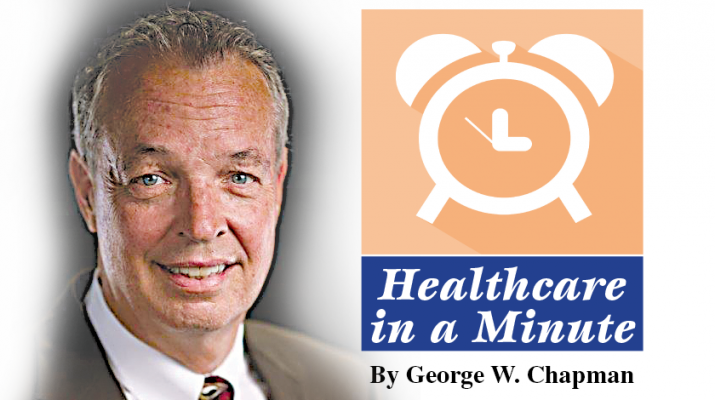By George W. Chapman
Thanks in large part to Vermont senator and presidential candidate Bernie Sanders, “Medicare For All” — or universal healthcare — has become a hotly debated topic for the 2020 campaign.
Detractors and skeptics have focused primarily on its impact on taxes. But here’s some food for thought as the debate rages on. U.S. taxes on wages and income are relatively low when compared to countries that have their own versions of Medicare for all. Our system of taxation is a “progressive” system whereby wealthiest pay a higher percentage of their income in taxes than middle- and lower-class taxpayers.
Unlike workers in England, France, Germany, Sweden, Finland and Canada, who are covered by universal care, American workers have health insurance contributions/responsibilities deducted directly from their paychecks. Out-of-pocket expenses like deductibles and copays are in addition to what is deducted from pay. So, unlike taxes on wages, healthcare premiums are not progressive. The lowest and middle wage earners pay the same per month as the highest wage earners. Consequently, the lower your wage or income, the higher your healthcare premium as a percentage of income. For example, a U.S. worker earning $43,000 a year pays an average of 37% in both taxes and health premiums. In high tax Finland, at the same earnings, a worker pays 23% in taxes which includes healthcare.
Moving toward a universal system would make healthcare costs more “progressive” for most Americans. No matter where you stand in this debate, healthcare “premiums” must be considered as a “tax” already being paid by the American worker.
Healthcare Drug Fraud
The DOJ recently convicted Phillip Esformes, a Florida skilled nursing facility owner, of over $1.3 billion in fraudulent claims to Medicare and Medicaid. Patients were referred to his shabby facilities where they received inadequate or unnecessary treatment. He bribed both physicians and regulators in order to defraud. He was convicted of conspiracy to defraud the U.S. government, kickbacks, money laundering and obstruction of justice. This is the largest healthcare fraud scheme to date. In another fraud case, drug manufacturer Questor, recently acquired by Mallinckrodt Pharmaceuticals, is accused of bribing physicians to unnecessarily prescribe “H.P. Acthar Gel,” which treats infant seizure disorders, multiple sclerosis, and rheumatoid arthritis. The price per vial went from $40 in 2000 to $39,000 today. If you’re doing the math, that’s a 97,000% increase. Medicare alone has spent $2 billion on the gel over the last several years. This was a whistleblower case. The “fraud police” only get involved in these cases when they are fairly certain of success. If convicted, Mallinckrodt would have to pay back what was deceitfully billed plus another $5,500 to $11,000 per false claim.
Primary Care Spending Low
A basic tenet of healthcare is that primary care management improves overall health outcomes and lowers costs. Researchers at the RAND Corporation studied 16 million Medicare claims and found that primary care accounts for less than 5% of total Medicare spending on physicians, hospitals/facilities, supplies and drugs. For the study, “primary care” included family practitioners, internists, gynecologists, geriatricians, nurse practitioners and physician assistants. Clearly, there is plenty of room for more investment in primary care. One way is to pay providers more for primary care services which would encourage more medical students to specialize in primary care.
Rural ERs Busier
Despite the fact that many rural hospitals are in danger of closing, visits to rural emergency departments are up over 50% in recent years, according to a study published in the Journal of the AMA. Visits to urban/suburban emergency departments for the same time are up just 5%. Non-Hispanic white patients 18-64, Medicaid beneficiaries and the uninsured lead the charge. Rural hospitals are increasingly becoming the safety net providers in their markets. Increased ER visits, especially in rural areas, can somewhat be attributed to the shortage of primary care physicians that is much more endemic to rural areas. With limited primary care options, rural residents are forced to use emergency rooms.
Chronic Diseases Costly
The annual cost of chronic diseases like heart disease, obesity, diabetes, cancer and Alzheimer’s is staggering. According to a report by Fitch Solutions, it is $3.8 trillion a year in direct and indirect costs. That is almost 20% of our GDP. And the cost could double in the next 30 years as baby boomers age and live longer. Indirect costs include lost productivity, early retirement and premature mortality.
Telehealth Trending Up
Two of the necessary three factors for acceptance by physicians are in place and pushing the use of telemedicine. The first factor is the physician shortage. Telehealth gives overwhelmed physicians another tool to handle their heavy patient loads as not everyone has to be seen in the office. The second factor is consumer preference, especially among younger patients who are very comfortable using technology. The third factor for overall acceptance of telehealth by physicians is insurance payments. They are getting better, but not quite there yet. While the majority of specialties are just beginning to feel comfortable with telehealth, it has been incorporated into radiology, dermatology, psychiatry and cardiology for years. Medicare (CMS) is planning to boost telehealth benefits next year. Typically, commercial carriers follow suit. In the meantime, Humana is about to roll out a virtual primary care model called “On Hand” through the telehealth company “Doctor on Demand.” The plan offers members access to a dedicated primary care physician, urgent care and behavioral health through video visits, all at a relatively low monthly payment. Interested employers see this as a way to save money and reduce employee absences. There is no co-pay for the virtual visits.
George W. Chapman is a healthcare business consultant who works exclusively with physicians, hospitals and healthcare organizations. He operates GW Chapman Consulting based in Syracuse. Email him at gwc@gwchapmanconsulting.com.

